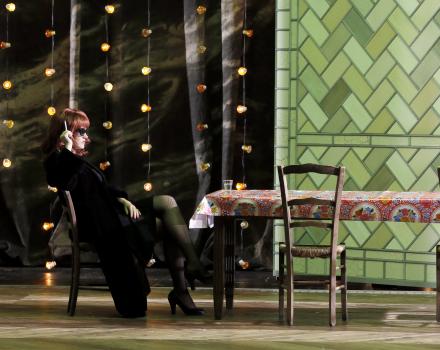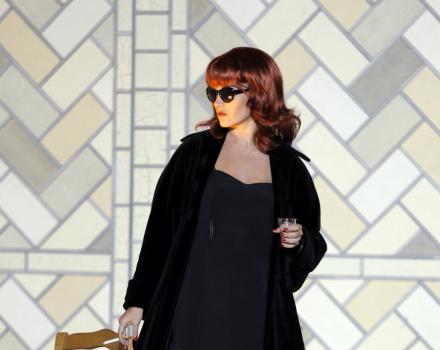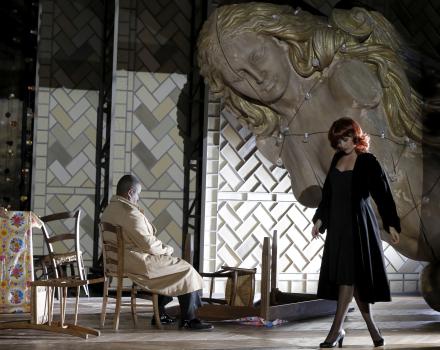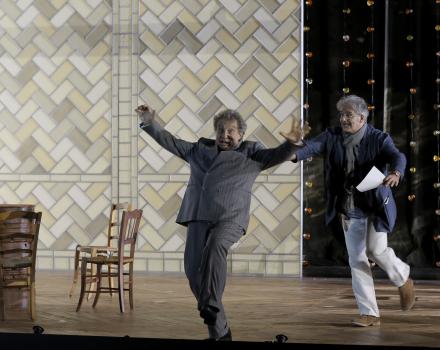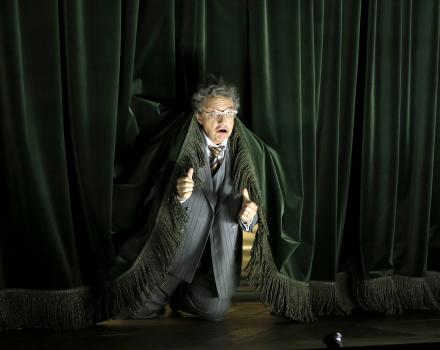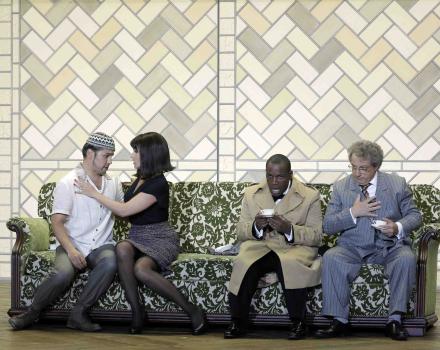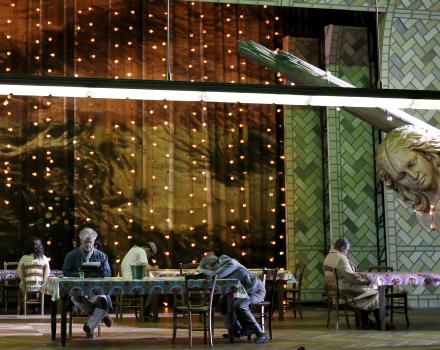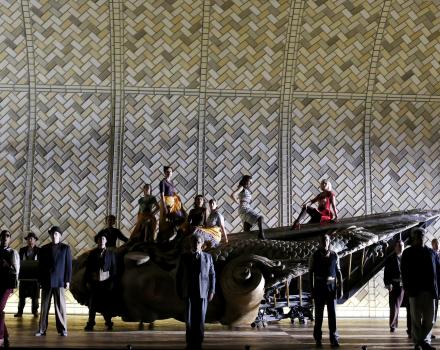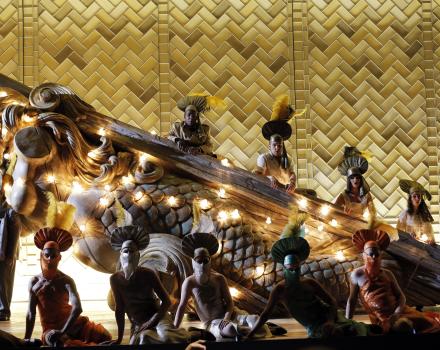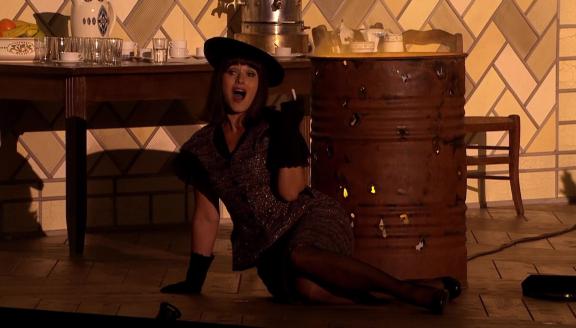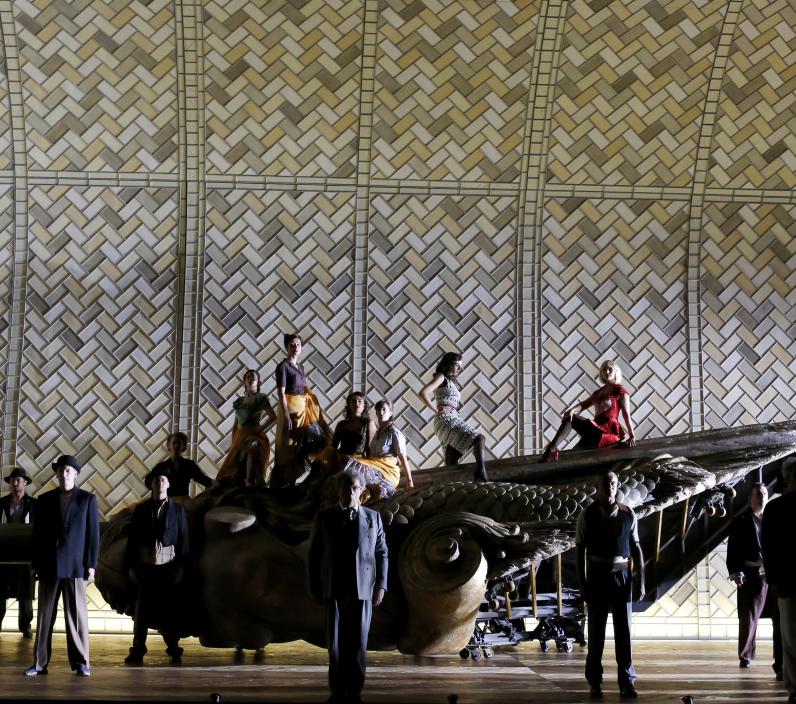
Il turco in Italia

In the bright sunlight of opera buffa, a handsome Turkish prince (with an agile bass voice) lands on the coast of Naples looking for amorous adventures. In no time at all he meets a vivacious Italian girl (a coquettish virtuoso soprano), who is accustomed to flitting between admirers, much to the displeasure of her elderly husband. This little group carries on its flirtations, rivalries and quarrels under the delighted eyes of the poet Prosdocimo, who, as it happens, has been seeking inspiration for a dramma buffo.
Il turco in Italia shows composer Gioacchino Rossini at his funniest and also his most subtle. He responds to the buffoonery of the plot with an inspired and constantly amusing score. Il turco in Italia is largely an ensemble opera with only Fiorella - she of the coquettish passion for men - having an important series of solo arias. Amidst the madcap antics, Rossini steps back, for dramatic or musical reasons, to create moments of extraordinary beauty and sensitivity. This production from the Festival d'Aix-en-Provence is directed by New Yorker Christopher Alden, and features Les Musiciens du Louvre Grenoble conducted by Marc Minkowski and a stellar cast including: Adrian Sâmpetrean, Olga Peretyatko, Alessandro Corbelli, Lawrence Brownlee and Pietro Spagnoli.
Cast
|
Selim
|
Adrian Sâmpetrean
|
|---|---|
|
Fiorilla
|
Olga Peretyatko
|
|
Don Geronio
|
Alessandro Corbelli
|
|
Narciso
|
Lawrence Brownlee
|
|
Prosdocimo
|
Pietro Spagnoli
|
|
Zaida
|
Cecelia Hall
|
|
Albazar
|
Juan Sancho
|
|
Orchestra
|
Les Musiciens du Louvre-Grenoble
|
|
Chorus
|
Ensemble vocal Aedes
|
| ... | |
|
Music
|
Gioachino Rossini
|
|---|---|
|
Text
|
Felice Romani
|
|
Conductor
|
Marc Minkowski
|
|
Director
|
Christopher Alden
|
|
Sets
|
Andrew Liebermann
|
|
Costumes
|
Kaye Voyce
|
|
Lighting
|
Adam Silverman
|
| ... | |
Video
STORY
ACT I
The arrival of a band of Gypsies in a seaside town is good news for the poet Prosdocimo: perhaps they will give him some material that he can turn into the plot for a new play. And sure enough, along comes Don Geronio to consult the Gypsies about his flighty wife Fiorilla. Zaida and the other Gypsy women make so many references to animals with horns that Geronio retreats. The Poet questions Zaida and she tells him of her misfortune: she was going to marry the Turkish prince Selim Damelec, but he has unjustly condemned her to death. She has been rescued by the faithful Albazar, with whom she has escaped.
Zaida departs and Fiorilla comes on, singing in praise of the heart’s fickleness. A ship draws near to the shore. A Turkish prince disembarks: it is Selim. He strikes up an acquaintance with the pretty Italian girl, and they go off together, chatting and joking. As the Poet returns he passes Don Narciso, Fiorilla’s lover, who is fuming with jealousy. Then Don Geronio appears, beside himself with rage at the sight of his wife on the arm of a Turk! The Poet is delighted, as he now has all the elements of a farce.
Fiorilla has invited Selim to have coffee at her house, but they are interrupted by Geronio. Making the best of the situation, Fiorilla forces her husband to kiss the visitor’s coat. Then Narciso arrives and, seeing the humiliating position Geronio is in, tells him not to let himself be pushed around. Selim slips away. Geronio complains to the Poet, who advises him to discipline his wife (in the hope that this will make his play more entertaining). And indeed, the couple embark on a spectacular row.
While waiting for Fiorilla, so that they can run off together, Selim meets the Gypsies… and recognises Zaida. But at that moment Narciso, Geronio and finally Fiorilla all arrive. Fiorilla is furious when she sees Selim with another woman. The Poet encourages all the shouting, astonishment and confusion.
ACT II
The Poet presses Geronio to have a drink to give him courage – otherwise his comedy would grind to a halt. Selim comes in and makes an offer to Geronio to buy his wife. Fiorilla has brought Zaida along and makes the Turk choose between them. Selim cannot resist the beautiful Fiorilla, but once Zaida has been sent away he cannot help feeling sorry for the unfortunate woman, which infuriates Fiorilla. A duet is enough to bring them together again. Then the Poet reveals to Geronio his plan to stop Fiorilla being abducted: at a masked ball Zaida will pretend to Selim to be Fiorilla. Overhearing this, Don Narciso decides he will also go to the ball – disguised as Selim.
During the ball, with the help of the disguises, Narciso approaches Fiorilla, who follows him, believing him to be Selim, while the latter joins up with Zaida, unaware of who she really is. Geronio is totally bewildered. The Poet comes to his rescue, urging him to threaten his wife with divorce. Coming back from the ball, Fiorilla bumps into her husband who banishes her from the marital home. The Poet gives Fiorilla a letter stating that her husband repudiates her. Overcome by remorse she repents of her behaviour – to the Poet’s satisfaction, as his comedy will now have a moral ending!
Despairing, Fiorilla has decided to leave the Neapolitan coast and go back to live with her humbly born parents. But Geronio rushes up to forgive her. As for Selim, he sets off for home together with Zaida. They all sing in praise of this happy ending.
Insights
Six characters in search of a director
Interview with Christopher Alden
Is Il turco in Italia just an opera buffa?
Christopher Alden: The libretto is deeper than it seems; it features characters who try to cross their own boundaries and dare to venture into areas that are often unexplored. Despite coming from radically opposed cultures, the characters of Selim and Fiorilla, one Turkish, the other Italian, are irresistibly attracted to, fascinated by, each other. More than just an opera buffa, Il turco in Italia is an opera about difference, between cultures on the one hand and between men and women on the other.
How does Il turco in Italia differ from the rest of Rossini's output?
I consider Il turco in Italia to be one of Rossini's most fascinating operas. It stands out above the rest for a certain perversity, embodied by the figure of the poet Prosdocimo: this man, in search of a valid argument for his opera libretto, draws inspiration from the people around him. He incites them, in a more or less insidious way, to behave in ways designed to serve his plot. In a way, he tries to manipulate them.
What is your approach to directing the opera?
My approach is more dreamlike than realistic. I was very inspired by the figure of the Poet who, in my version, takes on the features of an opera director under whose guidance the other characters rehearse. The Poet is a familiar figure to me. I do much the same thing as he does when, at home, sitting at my desk, I prepare a production. I gather my ideas, listen to records, study the identity of the characters and explore every nook and cranny of the work. This almost obsessive work is something we both experience!
Rossini specialist Damien Colas maintains that ‘the real protagonist of Il turco is not Selim but Fiorilla’.
The role of Fiorilla, a feminist before her time in a patriarchal society, is quite unusual in 19th-century opera. Fiorilla refuses to play the role of good wife assigned to her and to accept her petty-bourgeois marriage. To escape this situation, she pushes back the boundaries of her sexuality by taking on a quasi-masculine role.
It is interesting to note that a chorus of women is present at the beginning of the opera, then disappears to make way for Fiorilla alone. The spectator then witnesses the contradictory feelings that the young woman triggers in the men around her: they love her, desire her and at the same time fear her, hate her and are jealous of her. Like Lulu and Carmen, Fiorilla is one of those strong women whom men want to subjugate at all costs. Like Catharina in Shakespeare's The Taming of the Shrew, despite her good intentions, Fiorilla finds herself defeated and chooses the reassuring comfort of marriage.
What about the happy ending, which seems at odds with the reality of the characters?
It's a conventional happy ending because the end of the opera is rather sad. The outcome of Il turco in Italia presents characters who have been destroyed, stripped of their joie de vivre and even their sexuality, who have burnt their wings in contact with desire, and end up having to renounce their ideals. Neither Fiorilla nor Selim have the courage to transgress their situation, and each retreats into their own culture.
Can this opera still speak to audiences today?
This opera can still speak to today's audiences insofar as it tackles the universal question of human relationships, and the ever-topical relationship between men and women. Il turco in Italia shows the weight of social norms: the characters see the difficulty of fighting to achieve freedom of expression as individuals. This is a subject that concerns us all.
Adapted from an interview between Christopher Alden and Anne Le Nabour.
Gallery
